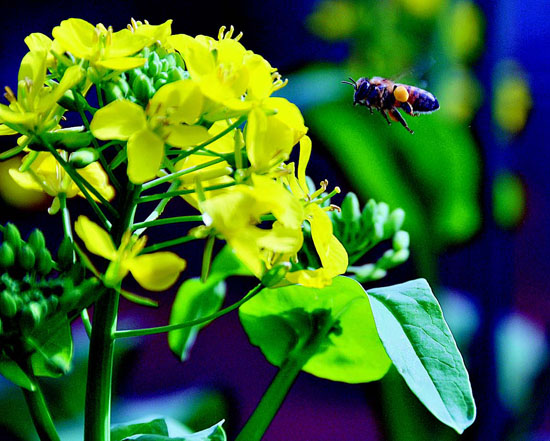 |
|
|
A honeybee heads for a mustard flower. Photo Andy Scheck
|
|
|
|
|
|
With the warmer winter weather, spring is in the air. And so are the honeybees - out flying, gathering pollen, nectar and water to bring back to the hive. Warmer weather also brings us out to our gardens. As you look around and make plans for the sunny days ahead, do a few simple things to help the honeybee. She will reward your efforts by pollinating the flowers to make your fruit trees and vegetable gardens more abundant. And her honey will surely find its way to your local farmers' market and onto your table.
 If you have a sunny spot in your yard, plant lavender or rosemary. These attractive shrubs are easy to grow, drought tolerant and long blooming. If you have part shade, plant spearmint, hummingbird sage, campanula or bee balm. Other bee friendly plants that flourish in our region are ceanothus, wisteria, asters, sunflowers, borage, many salvias and thyme.
If you have a sunny spot in your yard, plant lavender or rosemary. These attractive shrubs are easy to grow, drought tolerant and long blooming. If you have part shade, plant spearmint, hummingbird sage, campanula or bee balm. Other bee friendly plants that flourish in our region are ceanothus, wisteria, asters, sunflowers, borage, many salvias and thyme.
 Honeybees practice "flower fidelity," foraging on one plant species at a time. Where possible, grow a single type of plant in a patch of at least one square meter. You'll be reducing the distance the honeybee must fly from flower to flower letting her work more efficiently.
Honeybees practice "flower fidelity," foraging on one plant species at a time. Where possible, grow a single type of plant in a patch of at least one square meter. You'll be reducing the distance the honeybee must fly from flower to flower letting her work more efficiently.
 Here's another simple thing you can do right now, as soon as you put down this paper. Place an old dinner plate or pie tin beneath one of your drip lines or sprinkler heads so it will refill regularly. Honeybees need a reliable source of clean water all year long. They will remember and return to your improvised water feeder every day, just like a bird, so keep it in the same place and keep it flowing. Place a mound of pebbles on the plate so the bees can take a sip of water without falling in.
Here's another simple thing you can do right now, as soon as you put down this paper. Place an old dinner plate or pie tin beneath one of your drip lines or sprinkler heads so it will refill regularly. Honeybees need a reliable source of clean water all year long. They will remember and return to your improvised water feeder every day, just like a bird, so keep it in the same place and keep it flowing. Place a mound of pebbles on the plate so the bees can take a sip of water without falling in.
 It has been a tough year on honeybees. Colony losses among my beekeeping friends exceeded 50 percent. There are many reasons for honeybee mortality; chemical poisonings are one factor. Please avoid using herbicides and pesticides. Instead, trap the yellow jackets (they attack honeybees, too). Use ladybugs to go after aphids. Dump standing water to prevent mosquitoes. If you must spray for pests, choose a product that is non-lethal to honeybees. At the very least, spray at dusk when the honeybee has returned to her hive.
It has been a tough year on honeybees. Colony losses among my beekeeping friends exceeded 50 percent. There are many reasons for honeybee mortality; chemical poisonings are one factor. Please avoid using herbicides and pesticides. Instead, trap the yellow jackets (they attack honeybees, too). Use ladybugs to go after aphids. Dump standing water to prevent mosquitoes. If you must spray for pests, choose a product that is non-lethal to honeybees. At the very least, spray at dusk when the honeybee has returned to her hive.
 Mother Nature does her part to help the honeybee. Outside your garden walls, the rains bring up the mustard that blooms across our open hillsides providing good forage for bees. More wildflowers will follow. The honeybee knows no boundaries and will fly to wherever nutritious flowers bloom. With very little effort, you can invite her into your garden helping both your plants and the honeybees to thrive.
Mother Nature does her part to help the honeybee. Outside your garden walls, the rains bring up the mustard that blooms across our open hillsides providing good forage for bees. More wildflowers will follow. The honeybee knows no boundaries and will fly to wherever nutritious flowers bloom. With very little effort, you can invite her into your garden helping both your plants and the honeybees to thrive.
 Meanwhile, pray for rain. How easy is that?
Meanwhile, pray for rain. How easy is that?
 Janet Kaidantzis is a backyard beekeeper in Lafayette and a member of the Mt. Diablo Beekeepers Association.
Janet Kaidantzis is a backyard beekeeper in Lafayette and a member of the Mt. Diablo Beekeepers Association.

|
